A Govardhana Shila is rock from the Govardhan Hill in Braj. Govardhan Hill holds a unique position in Hindu scriptures related to Krishna, the land called Vrij where He was born. Known as Govardhan or Giriraj and being the sacred center of Braj, it is identified as a natural form of Krishna. Indian art overwhelmingly prefers the iconic image, but some aniconism does occur in folk worship, early Buddhism, Shiva's Banalinga, and Vishnu's Saligrama Sila (murthi)). They have solar significance, and their use in worship predates the Hindu period in India . The stone is usually brown in color. Govardhan, a very famous place of Hindu pilgrimage, is located 26 km west of Mathura (154 km from New Delhi) on the state highway to Deeg. Govardhan is located on a narrow sandstone hill known as Giriraj which is about 8 km in length. When Chaitanya Mahaprabhu did parikrama (circumambulation) of Govardhana Hill while visiting Vrindavana in 1515 AD, he did not walk on the hill because he considered Govardhana as non-different from Lord Krishna. Therefore, traditionally Vaishnavas don’t step on Govardhan hill.
- circumambulation
- shila
- sila
1. Legend
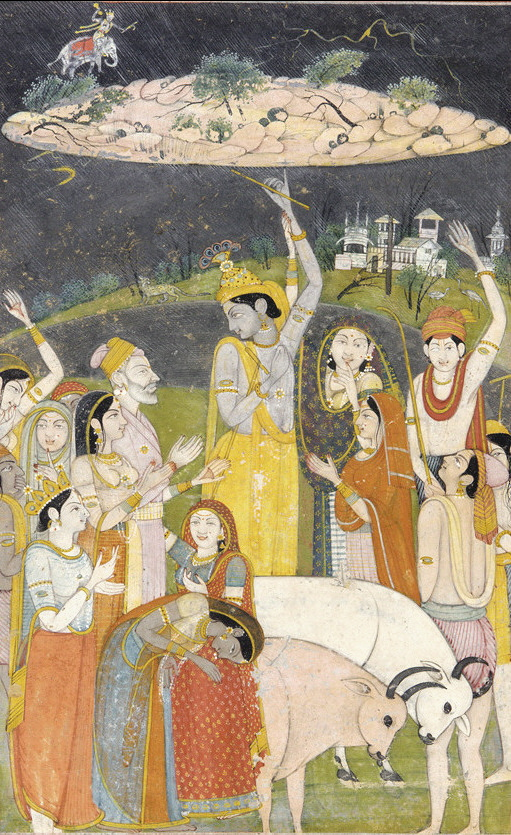
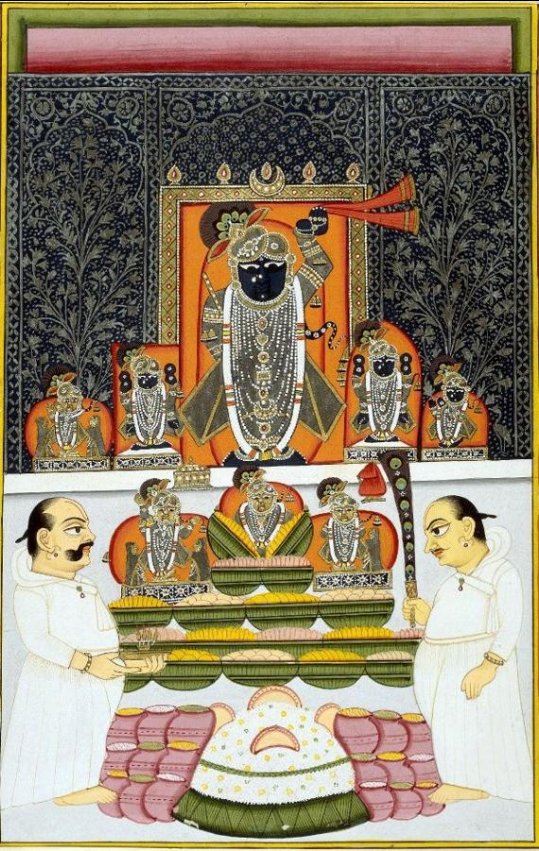
It is believed that thousands of years ago, Lord Krishna picked up a hill and held it above His head, with his pinky finger, for 7 days to protect his kinsfolk from the wrath of rain God Indra. This gave Krishna the epithet Govardhandhari. Since Lord Krishna declared that He and Govardhan Hill was non-different, the followers of the Vallabha Acharya tradition, devotees of Lord Krishna, worship Govardhan Sila. They worship Govardhana-silas along with the Saligrama sila, both considered as aniconic symbols of the Supreme Personality of Godhead, exactly as they worship the Deity of Krishna in the temple. Lifting of Govardhan Hill,Krishna's Lifting Govardhan Hill,Giriraj Govardhan Puja,Krishna Lifting Govardhan Hill,Sri Giriraj Govardhan Puja. English translation of the relevant texts on Govardahan Hill from Srimad Bhagvatam [1] state:
Krishna assumed a great transcendental form and declared to the inhabitants of Vrindavana that He was Himself Govardhana Hill in order to convince the devotees that Govardhana Hill and Krishna are identical. The identity of Krishna and Govardhana Hill is still honored, and great devotees take rocks from Govardhan Hill, and worship them exactly as they worship the Deity of Krishna in the temple.” (Srimad Bhagavatam 10.24.35 purport)
Of all the devotees, this Govardhana Hill is the best! O my friends, this hill supplies Krishna and Balarama, along with Their calves, cows and cowherd friends, will all kinds of necessities—water for drinking, very soft grass, caves, fruits, flowers and vegetables. In this way the hill offers respects to the Lord. Being touched by the lotus feet of Krishna and Balarama, Govardhana Hill appears very jubilant.” (Srimad Bhagavatam 10.21.18).
2. Govardahan Puja and Hill Parikrama
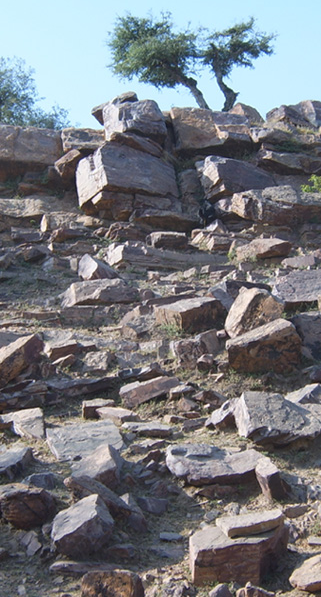
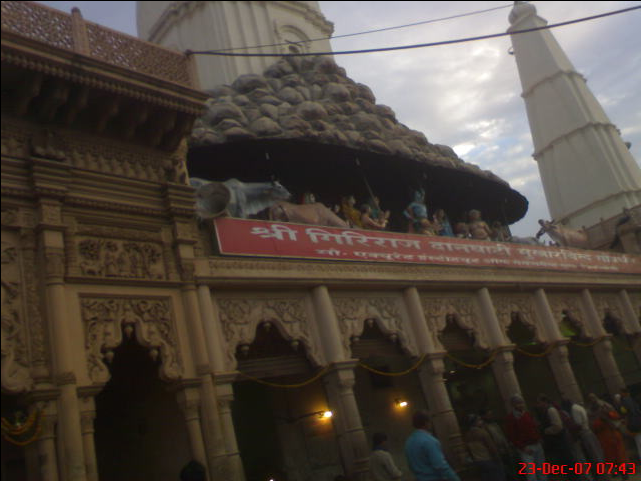
Presently at its highest point, the Govardhan hill is just 25m (80 feet) high and is a wide hill. It is a narrow sandstone hill known as Giriraj which is about 8 km in length.
After Krishna protected the inhabitants of Vraj (Vridavan) from the wrath of Indra, he counseled them to worship Govardhana hill and they did by way of a Puja and a Parikrama (circumambulation) around the hill. Thus, a festival in commemoration of the lifting of Mount Govardhan, near Mathura, by Krishna came into vogue as Govardhan Puja when Mount Govardhan is worshipped day after Deepawali (festival of lights) is celebrated.[3] Pious people keep awake the whole night and cook fifty-six (or 108) different types of food for the bhog (the offering of food) to Krishna. This ceremony is called ankut or annakuta which means a mountain of food. Various types of food – cereals, pulses, fruit, vegetables, chutneys, pickles, and salads – are offered to the Deity and then distributed as prasada to devotees. Thousands of devotees bring offerings for Giriraj. Followed by this pooja, the devotees perform the Govardhana parikrama.
A Parikrama [circumambulation- going 38 km {24-miles} around the hill] is a sacred ritual called Govardana parikrama performed by many believers. There is no time limit for performing Govardhana parikrama, but for those who perform the dandavata (full prostration) Parikrama, an arduous form which may take weeks and sometimes even months to complete. It is performed by standing in one spot, offering obeisances like a stick (danda) by lying flat on the ground and then continuing, contiguously, till the entire route is covered. It is also said that some sadhus (Hindu holy men) perform 108 dandavata Parikrama by offering 108 obeisances in one spot before moving to the next. This can take a number of months to complete.
This ritual of circumambulation is considered to be even better if it is done with milk. A clay pot filled with milk, with a hole at the bottom, is carried by the devotees in one hand and a pot filled with dhoop (incense smoke) in another. An escort continuously fills up the pot with milk till the circumambulation is completed. Circumambulation is also done with candy being handed out to children, en route.[4]
Parikrama of Govardhana starts at the Manasi-Ganga Kund (lake) and then after having darsan of Lord Harideva, from Radha-kunda village, where the Vrindavan road meets the parikrama path. After parikrama of 38 km, covering important tanks, shilas and shrines such as Radha Kunda, Syama Kunda, Dan Ghati, Mukharavinda, Rinamochana Kunda, Kusuma Sarovara and Punchari, it ends at Mansi Ganga Kund only.
3. Sites
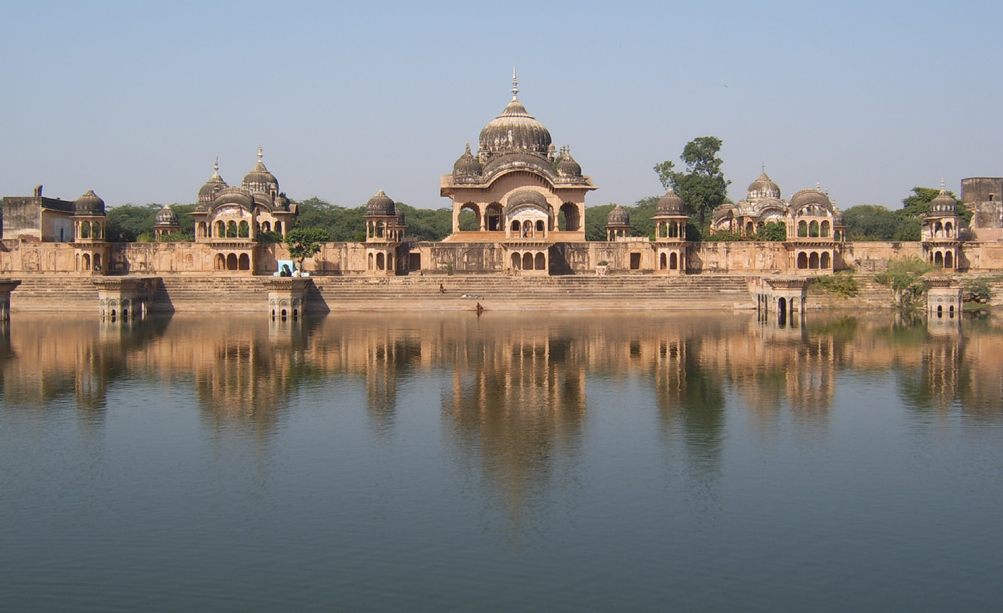
A few of the sites include:
- The sandstone monument and lake of Kusum Sarovar.[5][6]
- Giriraj Temple[67]
- Shri Chaitanya Temple, built of red sandstone and adorned with paintings of Krishna and Radha[78]
- Radha Kund Temple[78]
- Mansi Ganga Lake[78]
- Danghati Temple[78]
4. Shape of Govardhana Hill
In Govinda-lilamrita, Krishnadasa Kaviraja Gosvami states that Govardhana Hill is shaped like a peacock and that Radha Kunda and Syama Kunda are its eyes. Dan Ghati and Manasi Ganga are its long neck. Mukharavinda is the mouth, Kusuma Sarovara its face, and Punchari is its back and tail feathers. A peacock often curves its neck and puts his head under its stomach. Govardhana Hill is thus shaped in this pose of a peacock.[3][89]
5. Mala (Garland) of Gunja Seeds and Krishna
Followers of Chaitanya Mahaprabhu worship Krishna in a small stone form (Govardhana sila) representing Mount Govardhan, with a gunja mala (garland) around it representing Radharani. It is said that the child Krishna was inseparable from his favourite gunja maala which was said to represent Radha. This mythology has made the Gunjā (Abrus precatorius) seeds - the bright red seed of a fig tree - also a favourite for native jewellery.[910]
The only other God who shows a twig with a gunja seed on his upturned right hand palm to indicate the divya ksehtra’s superiority over Kashi (Varanasi) is Lord Narasimha, in the Gunja Narasimha Swamy temple locaterd at T.Narsipur in Mysore district in Karnataka on the bank of the Kaveri - Kapila - Spatika Sarovar sangam (confluence).
6. Recent Development
In 2018, the Uttar Pradesh Chief Minister Yogi Adityanath declared Govardhan as a pilgrimage centre (teerth sthal) along with Mathura, Baldev, Nandgaon, Radhakund and Gokul .[1011].Yogi Adityanath Government is also Plan ned to Rejuvenate Govardhan Parvat With Dwapar Yug Flora like kadamb, karoli, tamal, pakkad and tilkan[1112]
References
- Srimad Bhagavatam Canto 1 Chapter 3 Verse 28 http://srimadbhagavatam.com/1/3/28/en1
- Goverdhan Parikrama,Govardhan Parvat Parikrama,Govardhan Hill Parikrama,Parikrama of Goverdhan,Parikrama of Govardhan Parvat,Parikrama of Govardhan Hill http://www.girirajji.com/goverdhan-parikrama.html
- "Govardhan Puja". http://www.salagram.net/parishad77-g.htm.
- Know Thyself: July 2006 http://heenainindia.blogspot.com/2006_07_01_archive.html
- Henry George Keene (1878). A Handbook for Visitors to Agra and Its Neighbourhood. Thacker, Spink. pp. 71–72. https://archive.org/details/ahandbookforvis05keengoog. error
- Ritika Handoo (2 December 2016). "Here Lord Krishna lifted Govardhan hill—This can be your travel guide to reach Giriraj Temple!". http://zeenews.india.com/travel/here-lord-krishna-lifted-govardhan-hill-this-can-be-your-travel-guide-to-reach-giriraj-temple_1955285.htm. Retrieved 7 April 2017. Henry George Keene (1878). A Handbook for Visitors to Agra and Its Neighbourhood. Thacker, Spink. pp. 71–72. https://archive.org/details/ahandbookforvis05keengoog.
- Amit Sengupta (16 June 2015). "Spiritual Sojourn (sic) in Govardhan". http://www.moneylife.in/article/spiritual-soujourn-in-govardhan/42258.html. Retrieved 7 April 2017. Ritika Handoo (2 December 2016). "Here Lord Krishna lifted Govardhan hill—This can be your travel guide to reach Giriraj Temple!". http://zeenews.india.com/travel/here-lord-krishna-lifted-govardhan-hill-this-can-be-your-travel-guide-to-reach-giriraj-temple_1955285.htm. Retrieved 7 April 2017.
- Sri Govardhana Hill, Glories of Govardhana Hill, Glories of Giriraja Govardhana, Radha Kunda, Glories of Radha Kunda, Sri Giriraja Govardhana http://www.girirajji.com/glories-of-goverdhan-hill.htmlAmit Sengupta (16 June 2015). "Spiritual Sojourn (sic) in Govardhan". http://www.moneylife.in/article/spiritual-soujourn-in-govardhan/42258.html. Retrieved 7 April 2017.
- Flowers in Ancient Literature http://www.flowersofindia.net/mythology.htmlSri Govardhana Hill, Glories of Govardhana Hill, Glories of Giriraja Govardhana, Radha Kunda, Glories of Radha Kunda, Sri Giriraja Govardhana http://www.girirajji.com/glories-of-goverdhan-hill.html
- https://m.timesofindia.com/city/agra/five-more-places-declared-as-teerth-sthals-in-mathura/articleshow/63431972.cmsFlowers in Ancient Literature http://www.flowersofindia.net/mythology.html
- https://swarajyamag.com/insta/yogi-adityanath-government-plans-to-rejuvenate-govardhan-parvat-with-dwapar-yug-florahttps://m.timesofindia.com/city/agra/five-more-places-declared-as-teerth-sthals-in-mathura/articleshow/63431972.cms
- https://swarajyamag.com/insta/yogi-adityanath-government-plans-to-rejuvenate-govardhan-parvat-with-dwapar-yug-flora
